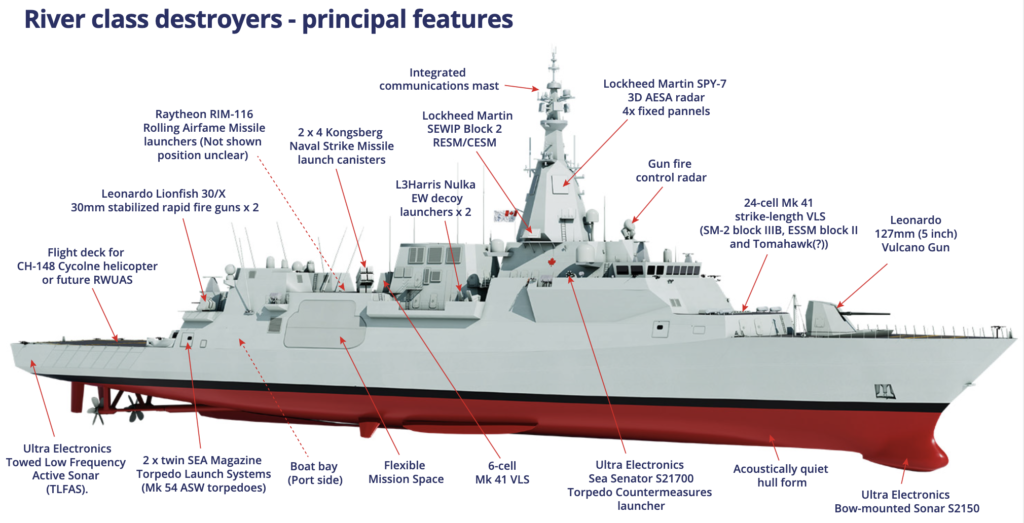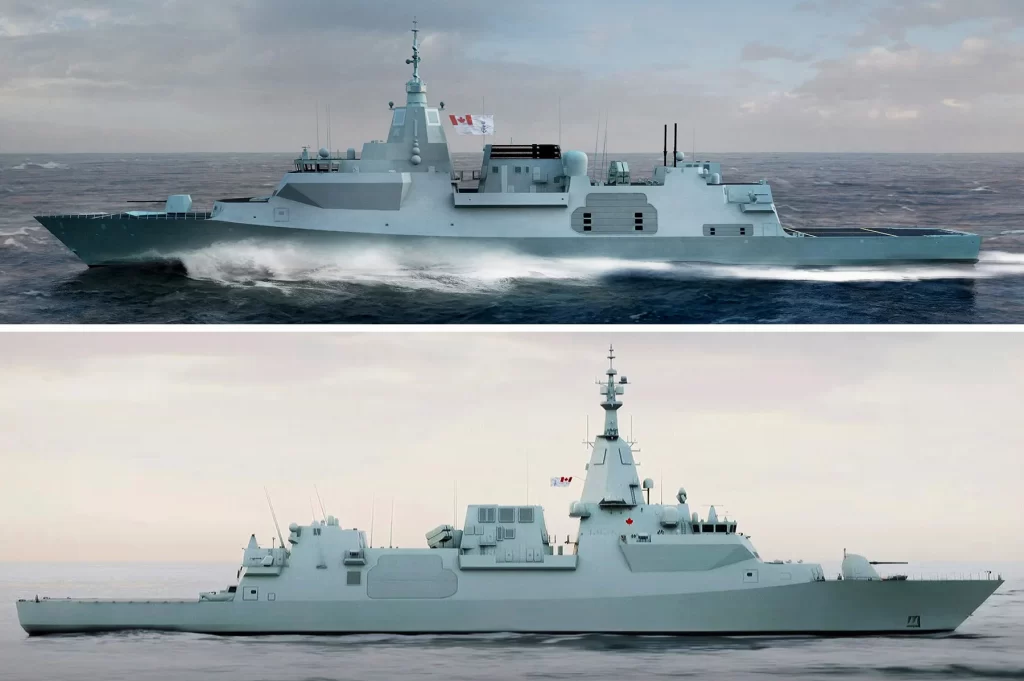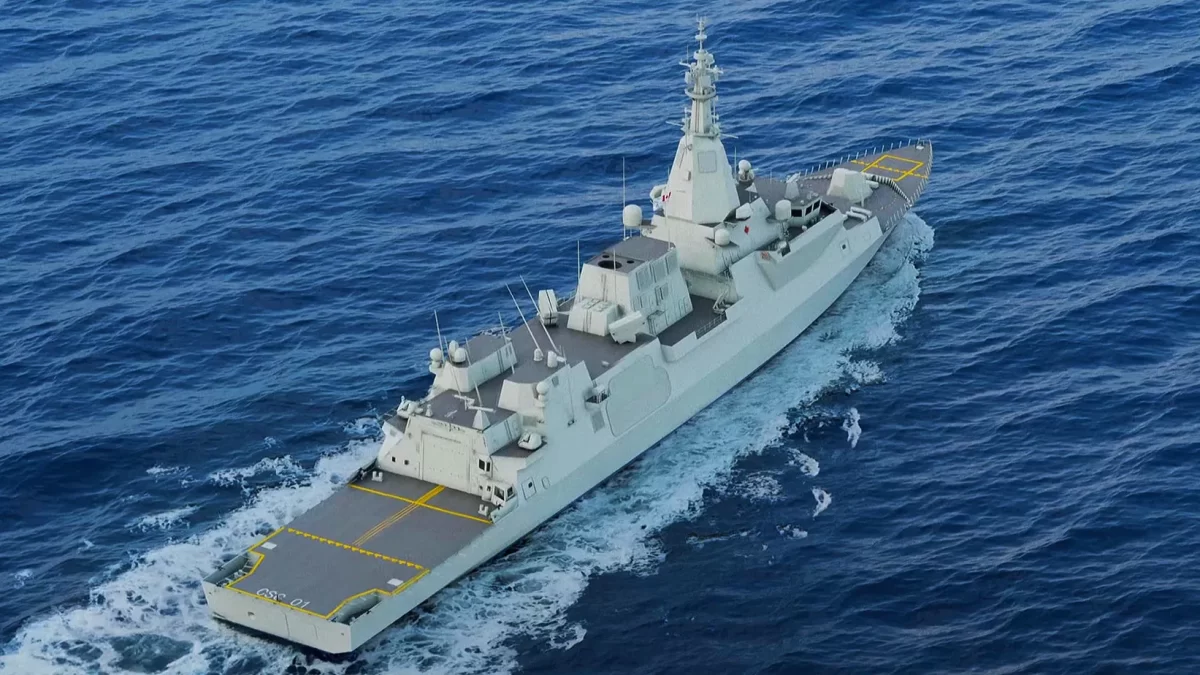On June 28th, the Canadian Navy celebrated the commencement of construction on its new River-class destroyers. These ships represent a significant evolution from the Royal Navy’s Type 26 frigate, tailored to meet Canada’s specific needs.
Project Background
In 2018, the Type 26 frigate was selected as the foundational design for Canada’s Surface Combatant (CSC) project. This ambitious program aims to replace the aging fleet of four Iroquois-class destroyers and twelve Halifax-class frigates with up to 15 new ships. Six years later, the project has reached a milestone with the first steel cut for a Production Test Module (PMT) at Irving Shipbuilding’s Halifax facility. This step follows the successful approach of BAE Systems Maritime Australia for their Hunter class, allowing for process refinement before full-scale shipbuilding begins next year.

Design and Classification
The new Canadian ships will be known as the River-class destroyers, classified as guided missile, helicopter-capable destroyers under NATO designation DDGH. While the Royal Navy’s Type 26 is focused on anti-submarine warfare (ASW) and classified as a frigate, Canada’s River-class includes extensive modifications to enhance air defence capabilities. Weighing around 8,000 tonnes, these destroyers are reminiscent of light cruisers of the past. The first batch will include HMCS Fraser, HMCS Saint-Laurent, and HMCS Mackenzie. Additionally, the land-based test facility will be named HMCS Assiniboine.
Timeline and Financial Considerations
The Royal Canadian Navy (RCN) has not specified when HMCS Fraser will enter service, stating only that it will be “sometime in the 2030s.” If all 15 ships are constructed, the final one will not be commissioned until the 2050s. The official budget for the CSC project is CAD $56-60 billion, but a Parliamentary Budget Officer report estimates the cost at CAD $84 billion. With Canada’s defense budget at only 1.25% of GDP, funding all necessary modernization projects poses a significant challenge.
Development and Modifications
Both Canada and Australia have extensively modified the Type 26 design to suit their needs. Each country chose this high-end ASW frigate as the best fit for their requirements, incorporating different weapons and combat systems and enhancing air defense capabilities. These modifications have driven up costs and caused delays, sparking debate about whether a smaller alternative could have been more economical.
Significant design refinements have been made since the Type 26 was selected for the CSC project. Visible changes include a new medium-caliber gun, a redesigned radar on a taller main mast, and repositioned Naval Strike Missile launchers. Secondary communication masts have been removed, giving the River-class ships a streamlined appearance.

Armament and Systems
The CSC ships will replace the UK-designed CAMM/Sea Ceptor missile system with the RIM-116 Rolling Airframe Missile (RAM), likely as a cost-saving measure. Despite this change, the ships retain the capability to house CAMM missiles in Mk 41 cells. The primary missile armament will include Raytheon SM-2 Block IIIC medium-range air defense missiles and Evolved Sea Sparrow Missiles (ESSM) Block II, alongside the Kongsberg Naval Strike Missile.
The River-class will feature a new towed array sonar from Ultra Electronics and the same S2150 bow-mounted sonar as the Type 26. Additionally, Canada has opted for a Magazine Torpedo Launch System with twin launchers on each side. The Flexible Mission Space (FMS) midships can be equipped with various off-board systems, enhancing the ship’s capabilities, supported by Rolls Royce Canada’s Mission Bay Handling System.
The ships will also be armed with the Leonardo 127mm Oto Melara Vulcano gun, chosen for its lighter weight and advanced ammunition options. Instead of Phalanx CIWS, the River-class will feature two Leonardo Lionfish 30/X 30mm stabilized rapid-fire guns, offering increased range and firepower.
Combat Systems and Integration
The River-class combines the British-designed hull and propulsion of the Type 26 with different weapons, sensors, and combat systems. Central to their combat capability is the US AEGIS Combat Management System. In 2021, the US approved the sale of AEGIS systems, AN/SPY-7 radars, Cooperative Engagement Capability hardware, and Mk 41 VLS shipsets to Canada. These will equip the first three destroyers and the land-based test facility. The SPY-7 radar supports integration with NORAD and seamless operations with the US Navy.
Future Outlook and Commonality
There is skepticism about whether Canada will build all 15 River-class ships, but the Type 26 program now has commitments from three navies, making it one of the most numerous major combatant types outside China and the US. Despite Australia reducing its Hunter class fleet, there is hope that Norway might order five Type 26s, built in the UK.
The shared platform among the participating navies will help reduce costs through economies of scale, shared operating experience, and logistical support. The Type 26 design brings significant economic benefits to the UK, with each Hunter or River-class ship built overseas contributing around £200M to the UK economy.
As the latest variant, the River-class benefits from lessons learned during the construction of its predecessors. While concerns remain about the capabilities of the Canadian shipbuilding industry and the high costs within a constrained defence budget, the River-class promises to be a well-balanced design. With top-tier ASW performance and robust air defense capabilities, its large size and mission bay allow for future modernization and the integration of modular payloads, ensuring adaptability for years to come.

